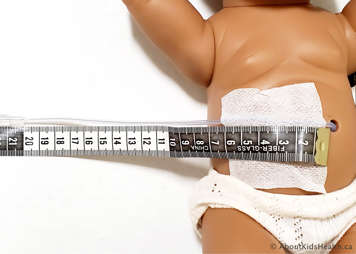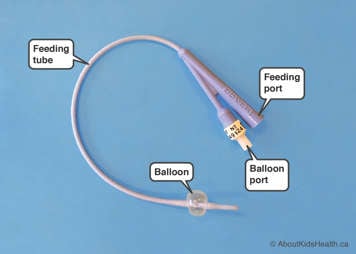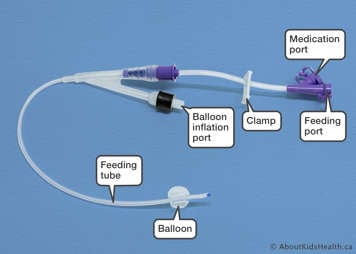The surgeon who put my child’s J Tube in was: Dr._______________________________
My child’s tube was inserted for the first time on: _______________________________
My child’s tube was last changed on: _______________________________
My child’s tube type is a (circle one): Foley / Broviac Catheter
My child’s tube size is: _______ FR
There is ____ mL of water in the balloon of my child’s tube
The external measurement of my child’s stoma is: ____________ cm
| The SickKids G-Tube Feeding Program has developed a one page guide to help you quickly troubleshoot any issues with your child's feeding tube: G-Tube Feeding Program Family One Pager |
What is a J tube?
A jejunostomy (J) tube is a type of feeding tube that is surgically inserted directly into the jejunum (part of the small intestine). J tubes are always inserted by a surgeon in an operating room. Your child will have a general anesthetic during the procedure. After the tube is inserted, your child will stay in the hospital for several days or more, depending on their condition.
The J tube is placed through an opening in your child's abdomen called a stoma. The tunnel from the outside through the stoma is called the tract.

Sutures
All surgically inserted J tubes will be sutured (stitched) to your child’s abdomen after surgery. These sutures (stitches) keep the tube secured to your child’s skin so it does not fall out accidentally. The stitches are non-dissolvable. They typically stay in for 8 weeks. If your child is discharged from hospital before the sutures are removed, they may fall out on their own at home or be removed by the surgeon at your follow-up appointment. The stitches may detach from the skin on their own at home. When this happens, sometimes some of the stitch string may be left wrapped around the tube. Do not remove the stitches from your child’s skin or from around the tube on your own.
Dressing

To prevent the tube from being accidentally pulled out or from moving further into the jejunum, your child’s J tube will be secured to the abdomen with a dressing. See the image below titled "How to coil a J tube under dressing" for an example of how to coil the J tube under the dressing.
To tape the tube to the abdomen, follow these instructions:
- Before taping the tube, always pull gently on the tube until you feel resistance of the balloon against the intestinal wall.
- Measure the length of the tube outside your child’s stomach - from the stoma to the end of the top of the tube. This helps you to know if the tube has accidentally moved further into the jejunum than usual (see the image on the right).
- Mark this measurement on the area provided at the beginning of this handout.
- Measure the length of the tube every day.
The dressing will need to be in place for 8 weeks. Change the dressing and clean your child’s skin with soap and water once per week.

After 8 weeks, use Hypafix tape to secure the tube. You may coil the tube slightly if your child pulls at the tube. Keep the stoma open to air.
After surgery, there may be other dressings because of other procedural wounds. Manage these according to your surgical team’s recommendations.
Types of J tubes
Foley catheter type tube
Foley catheter type tubes have a balloon that sits on the inside of the jejunum to prevent the tube from being pulled out. They have a balloon port on the end to allow you to add and remove water from the balloon, as well as an opening to give feeds and medications through. Ask your child’s surgeon if they inflated the balloon, and if so, with how much water. The Foley catheter will be sutured (stitched) to the skin at first. After the sutures (stitches) are removed, the Foley will need to be taped to the abdomen at all times to prevent it from being pulled out.



Broviac catheter
A Broviac catheter is a long, soft tube make of silicone that is used for very small babies where a balloon would be too big. It will be sutured (stitched) in place at first.
Low profile "button" tubes
Some hospitals surgically insert a low-profile J tube, such as a Mic-Key.
The low-profile tube has an inflated balloon on the inside of the stomach to prevent the tube from being pulled out. Ask your child’s surgeon if they inflated the balloon, and if so, with how much water.
Low-profile tubes are usually inserted as a secondary tube, after an initial tube has been in place for at least 8 weeks.
Balloons
Surgically inserted J tubes have a balloon on the end that sits inside the jejunum to prevent the tube from being accidentally pulled out. The balloon may be inflated with sterile or distilled water. The amount of water you insert into the balloon will depend on what your surgeon recommends – usually no more than 1 mL. Ask your child’s surgeon about how much water the balloon was inflated with. Write this information in the area provided on this handout. Keep it somewhere easily accessible, such as on your phone or posted on the fridge.
The surgeon who inserts the tube may fill the balloon with less than the recommended balloon volume. If this is the case, you will need guidance from your health-care team before you increase the balloon volume.
Important: Putting more water in the balloon than recommended by your surgeon can lead to serious medical issues. An overinflated balloon could puncture through or obstruct the jejunum. If your child has increased leakage from the stoma, has increased abdominal pain, has a hard or distended abdomen or has had changes to their bowel movement pattern (more, less or no longer stooling), contact your surgeon for assistance.
Checking the balloon
To make sure the balloon on the end of the tube is not damaged, you will need to check the volume of water in the balloon at least once a week, starting once the tube has been in place for at least 8 weeks after primary insertion.
Don’t be alarmed if there is no water left in the balloon when you check for the first time – this is normal.
How to check the balloon:
- Insert a slip tip syringe into the balloon port. The balloon port is the opening with the hard white plastic.
- Remove all the water from the balloon. Throw the old water away. You may notice this water is discolored. This is normal.
- Re-inflate the balloon with the same amount of new sterile or distilled water you normally use.
Important notes about checking the balloon:
It is normal for less water to be removed from the balloon than what you put in, due to evaporation. There could be up to 0.5 mL less water. If there is a difference of more than 0.5 mL of water from what you put in and what you remove, the balloon may be damaged, and the tube may need to be replaced.
If you do not get any water back when checking the balloon, if you have been taught to change your child’s tube, remove the tube and check that the balloon is not broken. If the balloon is not broken, you can wash the tube and reinsert it. If the balloon is broken, you can replace the tube with a new one.
If you remove more fluids than what you put in or it looks like formula or medications, the balloon is damaged, and the tube will need to be replaced.
If you are not comfortable changing the tube yourself, even if the balloon is broken, you may still use the tube for feeding and medications. However, there is a risk the tube might move or fall out. Continue to tape the tube to the abdomen until you can have the J tube changed to a new tube.
You do not need to go to the emergency department if the tube is broken and you can secure it in place or change it yourself.
Feeding through a J tube
Feeding formula through a J tube must be done continuously using a feeding pump. This means you will give smaller volumes of formula over a longer period of time. For example, 20 mL/hour of formula over 20 hours. You should not give bolus feeds (bigger volumes over short periods of time) through a J tube.
Changing your child’s tube for the first time
Your child will likely start off with a small sized Foley catheter such as an 8FR. As your child grows, their surgeon may decide to increase the size of the tube. Eventually it may be possible to insert a low-profile tube. You and your child’s surgeon will decide when this may be possible.
The first Foley catheter change will happen with your surgical team approximately 8 weeks after the tube was inserted. Often, this is done at your child’s first follow-up clinic appointment with the surgeon. After that, the tube is changed as needed when the tube breaks or blocks.
Broviac catheters can only be changed after 8 weeks. The Broviac tube change must be done in the hospital’s interventional radiology department.
What to do if the J tube is accidentally pulled out
You must always have an emergency kit available, wherever you go. An emergency kit includes:
- an extra tube
- lubricant
- syringes
- sterile or distilled water
- tape
If your child’s tube has been in for less than 8 weeks
If your child’s J tube is partially pulled out, tape the tube in place, call your surgeon and go to the emergency department. The general surgery team will reinsert the tube or exchange it.
If the tube is pulled out all the way, do not attempt to insert a new Foley catheter. You must seek attention immediately to avoid the tract closing. Go directly to the emergency department where they will need to call the general surgery team urgently to help manage the tube re-insertion.
If the tube was inserted more than 8 weeks ago
It is important to insert a new J tube as soon as possible.
Check if the balloon on the current tube is broken by filling it with 1 mL of water. If you do not see a leak, you can wash and re-insert the same tube.
If the balloon is broken, to make sure the stoma and tract do not close, insert a new Foley catheter.
For instructions on how to insert a Foley catheter, please see the article "What to do if your child’s feeding tube is pulled out".
Note: In the article "What to do if your child’s feeding tube is pulled out", it will discuss checking the pH to confirm placement of the tube in the stomach. Since a J tube is not in the stomach, it is not necessary to do this step when changing a J tube.
If you are unsure that the tube is in the correct position, do not use it and contact your surgical team or go to the emergency department.
What to do if the tube becomes blocked
If the tube becomes blocked, there are many strategies to help unblock it. These include flushing with warm water and using pancreatic enzymes. If these strategies do not work, follow these instructions:
If your child’s tube was inserted less than 8 weeks
Call your surgeon and go to the emergency department.
If the tube was inserted more than 8 weeks ago
Change the tube yourself at home or, if you are not comfortable changing the tube yourself, contact the G tube specialist (at SickKids, this is the G tube resource nurse) or your surgical team. After hours, go to the emergency department for assistance.
Flush the tube with at least 5 to 10 mL of water before and after each tube feed and medication dose, and every 4 hours during continuous feeds to help prevent the tube from becoming blocked. To ensure this flush volume is safe for your child, discuss with your child's health-care team.
Daily care of your child’s J tube
- Keep the stoma as dry and clean as possible.
- Keep the tube well secured to prevent the tube from accidentally falling out.
- Clean the stoma with soap and water every day.
- Use hypertonic salt soaks to treat hypergranulation tissue.
At SickKids
G Tube Resource Nurse contact info:
Phone 416-813-7177
g.tubenurse@sickkids.ca
On the weekend/afterhours, you may need to come to the Emergency Department for an alternate method of feed/fluids/medication administration.